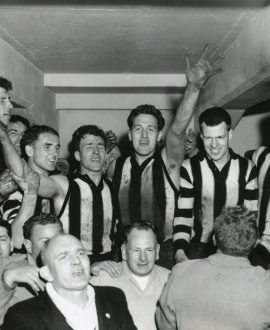

Any way you look at it, Bill Serong’s journey to Collingwood was an unusual one. And it’s equally hard to escape the conclusion that his Magpie adventure ended much sooner than it should have.
Serong was born and bred in Alexandra Parade, between Fitzroy and Collingwood. Although a Fitzroy supporter, Serong and his parents lived about 200 metres inside Collingwood’s zone. This virtually guaranteed Bill would wind up in the black and white colours, but for once a talented youngster very nearly slipped through the Collingwood net.
Serong attended St Thomas’ Catholic Boy’s College (CBC) at Clifton Hill, and it was here that he first played football. By his mid-teens he was playing three games a weekend; with the brewery team on Saturday morning, with Old Paradians on Saturday afternoons and with the local YCW side on Sundays. While at teachers’ college he also played mid-week. Serong’s performances were good but, like many other young hopefuls, not good enough to attract an advance from the Magpies.
On graduating from teachers’ college Serong’s first posting was at Terang, some 200 kilometres (120 miles) west of Melbourne. He enjoyed a wonderful 1955 season with the local football team, playing under former Footscray wingman Dick Wearmouth (Ron’s father). Serong dominated at centre half-forward and did well in both the best and fairest and goalkicking counts. When word of his performances filtered back to Melbourne, the VFL talent scouts were soon on the road to Terang. In all, six clubs approached him — and the last was a straggling Collingwood.
As Serong had been away less than two years he was still residentially bound to Collingwood. But that did not stop Geelong setting him up in a place at Ocean Grove in 1956 when his next teaching appointment took him to Sleepy Hollow. Luckily for Collingwood, Serong decided he wanted to start his VFL career that season — with the Magpies.
But in a bizarre twist, Serong trained with the Cats for virtually the entire 1956 season, his work commitments limiting him to only three or four runs at Victoria Park. It clearly did not affect Serong’s Saturday performances though; he marched straight into the senior team for the opening round and missed only one match for the year, and played well in the heat of the finals.
By 1957 the Education Department had thankfully moved him back to Melbourne and Serong was at last able to train with his Collingwood teammates. In those first two seasons Serong was a utility player in the strictest sense of the word, playing in virtually every position except full-back. There were flashes of clear brilliance, but he was still highly inconsistent. "Here's a six-footer who can run close to even time, rise for high marks and kick 60 yards," wrote The Sun in 1958. "But so far he hasn't quite lived up to expectations. "Has everything a top player needs - speed, height, strength and ability to kick strongly with either foot. On his day he can dominate a game."
But Collingwood was already grooming him to take over the centre position from Bill Twomey when he retired. Injuries during 1958 delayed those plans a little, but in 1959 and 1960 Serong played mainly in the centre and produced the best football of his League career.
Serong’s build was perfectly suited to playing in the pivot. He stood around 183cm (6ft) and weighed 86kg (13st 81b), giving him plenty of body strength. He was fast enough and his ground skills good enough to match it with small, speedy types. In addition he was a wonderful mark, with a great leap and a strong pair of hands.
He was renowned for his pace over those vital first few yards, that break being all he needed to create opportunities for his forwards. He was also superbly fit and could run all day, being one of the few footballers of his time who could meet famed athletic coach Percy Cerutty’s challenge to run a five-minute mile, and relished the wet weather game. He did not mind the physical contests either, as some of his contests in the 1958 Grand Final showed.
This combination of strength, agility and endurance not only made him a dangerous footballer but also a champion handballer (he was the youngest-ever player in the State Open team, was in the Victorian team for 30 years and won both Victorian and Australian titles).
So good were Serong’s performances in 1959 and 1960 that he finished third and second in the Copeland Trophy respectively. In 1959 he also finished equal second (with Ray Gabelich) in the Brownlow Medal. Still only 24, Serong looked certain to remain a key Collingwood player for years to come. But from preliminary final day 1960, things began to go horribly wrong.
Serong began that game picking up kicks at will. By midway through the second term he was clearly heading for best on ground when he broke his collarbone in a freak collision with a small Fitzroy opponent. The injury not only cost him a spot in the Grand Final side but also, most probably, the Copeland Trophy, as he went down to Gabbo by only a narrow margin.
Late in 1960, Serong’s mother died suddenly. Midway through 1961 his father also died, equally unexpectedly, leaving Bill to shoulder much of the family burden. He was studying law by this time and also working a number of different jobs – often shiftwork – to help his family. Not surprisingly his football suffered, and he decided to take a break after Round 14.
He missed the early part of the 1962 pre-season while completing more exams, but when he did finally turn up to Victoria Park could sense that something was wrong. Even so it was still a shock when, the day after the last practice match, the club’s 1961 vice-captain was dumped.
Given all that had happened to him in 1961 it is not unreasonable to expect that he might have been given a better chance to find form in 1962. Serong was bitterly disappointed but never grizzled or held a grudge. Three other clubs approached him and he eventually signed with North Melbourne, where he won the best and fairest in his first and only year. He then went to Echuca to do his articles, and captain-coached the local football team. In the years that followed he would win both club and competition best-and-fairests, despite suffering a severe ankle injury from which it was feared he would not recover.
These days, Bill Serong would have been given all the support in the world to get through the dual family tragedies that hit him so hard. It’s sad on so many levels that such support wasn’t available back then – and not least because it cost Collingwood the services of a fast, strong and brilliant centreman who still had plenty more to give.
- Michael Roberts
CFC Career Stats
| Season played | Games | Goals | Finals | Win % |
|---|---|---|---|---|
| 1956-1961 | 98 | 52 | 9 | 58.2% |
CFC Season by Season Stats
| Season | GP | GL | B | K | H | T | D | Guernsey No. | ||
|---|---|---|---|---|---|---|---|---|---|---|
Other CFC Games
| Team | League | Years Played | Games | Goals |
|---|---|---|---|---|
| Collingwood | Reserves | 1958 - 1961 | 6 | 8 |
Also Played For
| Team | League | Years Played | Games | Goals |
|---|---|---|---|---|
| North Melbourne | VFL | 1962 | 16 | 8 |
Awards









